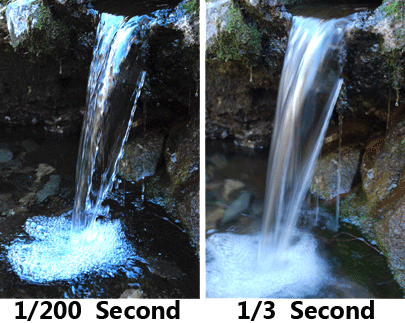READ: Shutter Speed
Shutter Speed
A fast shutter speed can capture fast moving objects or help clear blur from the shake in your hand when you are holding the camera. On the other hand, if you want to smooth or blur movement you should slow down the shutter speed. This is how to get that white soft look from waterfalls.
Shutter speed is measured in fractions of a second (1/speed). Example: 1/500 means that your shutter will be open for 1/500th of a second. As a general rule for hand held shots you want your shutter speed to be the inverse of your focal length or zoom, so if you have your focal length set to 50mm then your speed will probably need to be 1/50 to take into compensation for the shake in your hand. As you increase the speed of your shutter you will need more light from your subject or it will become underexposed.
Shutter speed not only can be used to control movement but it can be use to control how much light is recorded on your photo. Longer shutter speeds (or long exposures) record more light. Faster shutter speeds record less light.
This is why shutter speed is part of your exposure settings. If your shutter speed is too fast you will loose detail because of your photo being underexposed (too dark) and if it is too slow it will loose detail from being overexposed (too bright).  Shutter Speed can be a very useful feature on your camera. It can freeze or blur movement allowing the photographer to be very creative. Take a look at the two photos on the right side. I took those photos only changing the speed of the shutter.
Shutter Speed can be a very useful feature on your camera. It can freeze or blur movement allowing the photographer to be very creative. Take a look at the two photos on the right side. I took those photos only changing the speed of the shutter.
Shutter speed can be used to capture a water droplet in motion. The photo to the left used a fast shutter of 1/200 of a second to freeze the water droplet just before it broke away from the stream of water above it.